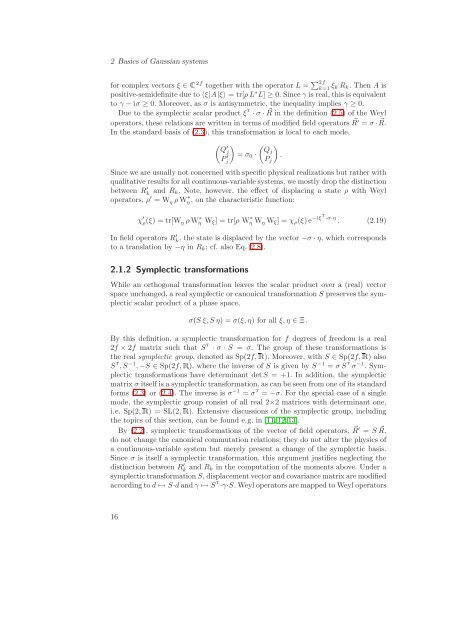Quantum Information Theory with Gaussian Systems
Quantum Information Theory with Gaussian Systems
Quantum Information Theory with Gaussian Systems
Create successful ePaper yourself
Turn your PDF publications into a flip-book with our unique Google optimized e-Paper software.
2 Basics of <strong>Gaussian</strong> systems<br />
for complex vectors ξ ∈2f together <strong>with</strong> the operator L = 2f<br />
k=1 ξk Rk. Then A is<br />
positive-semidefinite due to 〈ξ|A|ξ〉 = tr[ρ L ∗ L] ≥ 0. Since γ is real, this is equivalent<br />
to γ − iσ ≥ 0. Moreover, as σ is antisymmetric, the inequality implies γ ≥ 0.<br />
Due to the symplectic scalar product ξ T · σ · R in the definition (2.5) of the Weyl<br />
operators, these relations are written in terms of modified field operators R ′ = σ · R.<br />
In the standard basis of (2.3), this transformation is local to each mode,<br />
′ Q j = σ0 ·<br />
P ′ j<br />
Qj<br />
Since we are usually not concerned <strong>with</strong> specific physical realizations but rather <strong>with</strong><br />
qualitative results for all continuous-variable systems, we mostly drop the distinction<br />
between R ′ k and Rk. Note, however, the effect of displacing a state ρ <strong>with</strong> Weyl<br />
operators, ρ ′ = W η ρ W ∗ η, on the characteristic function:<br />
χ ′ ρ(ξ) = tr[W η ρ W ∗ η Wξ] = tr[ρ W ∗ η W η Wξ] = χρ(ξ)e −iξT ·σ·η . (2.19)<br />
In field operators R ′ k , the state is displaced by the vector −σ · η, which corresponds<br />
to a translation by −η in Rk; cf. also Eq. (2.8).<br />
2.1.2 Symplectic transformations<br />
While an orthogonal transformation leaves the scalar product over a (real) vector<br />
space unchanged, a real symplectic or canonical transformation S preserves the symplectic<br />
scalar product of a phase space,<br />
Pj<br />
<br />
.<br />
σ(S ξ, S η) = σ(ξ, η) for all ξ, η ∈ Ξ.<br />
By this definition, a symplectic transformation for f degrees of freedom is a real<br />
2f × 2f matrix such that S T · σ · S = σ. The group of these transformations is<br />
the real symplectic group, denoted as Sp(2f,Ê). Moreover, <strong>with</strong> S ∈ Sp(2f,Ê) also<br />
S T , S −1 , −S ∈ Sp(2f,Ê), where the inverse of S is given by S −1 = σ S T σ −1 . Symplectic<br />
transformations have determinant detS = +1. In addition, the symplectic<br />
matrix σ itself is a symplectic transformation, as can be seen from one of its standard<br />
forms (2.3) or (2.4). The inverse is σ −1 = σ T = −σ. For the special case of a single<br />
mode, the symplectic group consist of all real 2×2 matrices <strong>with</strong> determinant one,<br />
i.e. Sp(2,Ê) = SL(2,Ê). Extensive discussions of the symplectic group, including<br />
the topics of this section, can be found e.g. in [11,12,13].<br />
By (2.2), symplectic transformations of the vector of field operators, R ′ = S R,<br />
do not change the canonical commutation relations; they do not alter the physics of<br />
a continuous-variable system but merely present a change of the symplectic basis.<br />
Since σ is itself a symplectic transformation, this argument justifies neglecting the<br />
distinction between R ′ k and Rk in the computation of the moments above. Under a<br />
symplectic transformation S, displacement vector and covariance matrix are modified<br />
according to d ↦→ S·d and γ ↦→ S T ·γ·S. Weyl operators are mapped to Weyl operators<br />
16
















